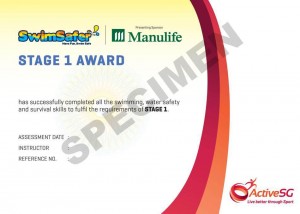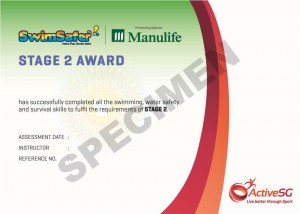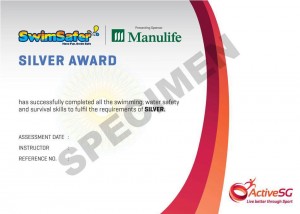SWIM SAFER

STAGE 1, 2 & 3
Start At The Beginning
This award is recommended for children aged 5 and above. Most are not able to achieve some of the basic skills. Even if they do manage to clear the first stage, it will take a long time for the to achieve the next. At Stage 3, children will be able to do basic frontstroke and backstroke of up to 50 meters.
STAGE 1, 2 & 3
Start At The Beginning
This award is recommended for children aged 5 and above. Most are not able to achieve some of the basic skills. Even if they do manage to clear the first stage, it will take a long time for the to achieve the next. At Stage 3, children will be able to do basic frontstroke and backstroke of up to 50 meters.

Getting More Graceful
Children must continue learning the 4 different styles in these stages. Frontcrawl, Backstroke, Breaststroke, Sidestroke and Survival Backstroke will be taught and improved until they can swim gracefully at Stage 6, covering 400 meters of physical endurance and challenge.
Kids Swimming Lessons
Only $70 per month
Stages Outline






Introduction to Water Skills
The objective is for your child to gain confidence and develop independence in the water, as well as learn general and deep-end water safety. Techniques taught include forward and backward movement, safe entry and exit, and introduction to personal water survival skills.
Entries & Exits
Enter the water safely and confidently with slide-in entry and exit using ladder and from pool edge.
Sculling & Body Orientation
- Recover from a face down float or glide to a standing position.
- Recover from a back float or glide to a standing position
Underwater skills
Submerge in waist depth water, open eyes and blow bubbles.
Movement/Swimming/Strokes
- Swim any stroke
- Forward movement 10m
- Backward movement 5m
Survival & Activity skills
- Support body in an upright position and signal distress.
- Grasp a floatation aid thrown for support and be pulled to safety
- Wearing clothing, correctly fit a PFD, jump into the water, float for 30 seconds and then climb out of deep water.
Knowledge
Rules of behavior in, on or near the water, water safety knowledge at a swimming pool.
Fundamental Water Skills
General skills development will include unassisted step entry into water, sculling, feet-first surface dives, personal water safety skills and water safety awareness in an aquatic environment. Your child will be encouraged to achieve 25 meters of continuous swim.
Entries & Exits
Perform a step-in entry
Sculling & Body Orientation
Demonstrate sculling in an upright position for 10 seconds with arms only
Underwater skills
Search for and recover an object in chest deep water depth.
Movement/Swimming/Strokes
Swim 25m – any stroke
- Breaststroke
- Backstroke
- Survival backstroke
Survival & Activity skills
- Swim wearing clothing for 15m.
- Demonstrate flotation survival technique
- Correctly fit a PFD, jump into the water and swim for 5 meters and climb out of deep water.
Knowledge
Water safety rules in various aquatic environments
Personal Water Survival and Stroke Development Skills
Principles of personal water survival and basic rescue skills will be tough. Your child will demonstrate proficiency in sculling, underwater skills, and the use of a Personal Flotation Device. Your child will be encouraged to achieve 50 meters of continuous swim.
Entries & Exits
Enter water using a compact jump
Sculling & Body Orientation
- Demonstrate sculling in a horizontal position for 10 seconds with arms only.
- Demonstrate the ability to change direction on command.
- Demonstrate reverse action
Underwater skills
In chest deep water swim through hoops on pool bottom 2 meters apart.
Movement/Swimming/Strokes
Swim 50m continuously.
- 25m using either breaststroke or front crawl
- 25m using backstroke or survival backstroke
Survival & Activity skills
- Swim wearing clothing for 25m
- Demonstrate ability to correctly fit a PFD in the water
Rescue skills
- Throw a floatation aid to a partner at 3m distance and instruct to kick to the edge.
- Perform a reach rescue using a rigid aid and pull a partner to safety.
Knowledge
Principles of personal survival
Personal Water Survival and Stroke Improvement Skills
Development of your child’s stroke technique will be a focus here, along with coordinated breathing in deep water while swimming 100 meters. Principles of water crafty safety will be introduced, as well as continuous work on rescue and personal water survival skills.
Entries & Exits
Enter water using a compact jump
Sculling & Body Orientation
Demonstrate a backward and forward somersault in the water
Underwater skills
- Search for and recover an object in 1.5m of water depth.
- Demonstrate a feet-first surface dive
Movement/Swimming/Strokes
Swim 100m continuously
- 25m Front crawl
- 25m Breaststroke
- 25m Backstroke
- 25m Survival Backstroke or Sidestroke
Survival & Activity skills
Dressed in swimwear, shorts and t-shirt, demonstrate 3min swimming slowly using any appropriate swim stroke, changing every minute
Rescue skills
- Perform a throw rescue using an unweighted rope over a distance of 6m.
- Wade to a person and deliver a floatation aid in deep water.
- Approach in “Ready” position.
Knowledge
Principles of water craft safety
Intermediate Personal Water Survival and Stroke Refinement Skills
Fundamentals of diving will be introduce. Development of rescue skills and personal water survival skills will also continue at more advanced levels. Your child will be required to demonstrate efficient stroke techniques to complete stage 5 before progressing to stage 6.
Entries & Exits
Demonstrate a dive entry (crouching)
Sculling & Body Orientation
Keep face above the water for 60 seconds sculling with hands only
Underwater skills
In 1.5m of water depth swim through hoops on pool bottom 3 metres apart.
Movement/Swimming/Strokes
Swim 200 m continuously.
- 50m Front crawl
- 50m Breaststroke
- 50m Backstroke
- 50m Survival Backstroke or Sidestroke
- Efficient stroke techniques must be used
Survival & Activity skills
Dressed in swimwear, long pants, long sleeved shirt, shoes and socks, perform the following sequence:
- Enter deep water using an appropriate entry method
- Submerge feet first, swim underwater for 3 meters.
- Resurface, skull, float or tread water for 3 minutes waving for help intermittently.
- Submerge feet first, swim underwater for 3 meters.
- Clothing may be removed.
- Correctly fit a PFD while treading water and then swim 25 meters and climb out of the water.
Rescue skills
Using a buoyant aid, accompanied (non-contact) rescue of a person 15m from safety
Knowledge
Recognising an emergency
Advanced Personal Water Survival and Swimming Skills Proficiency
Your child will be required to perform strokes with greater ease, efficiency, power and smoothness over 400 meters. Rescue skills and water safety knowledge will focus on lifesaving readiness. Standing dive and advanced personal water survival skills will continue to be taught.
Entries & Exits
Demonstrate a standing dive
Sculling & Body Orientation
Keep face above the water surface for 60 seconds using legs only
Underwater skills
- Search for and recover an object in 1.8m of water depth.
- Demonstrate equalizing of ear/nose
Movement/Swimming/Strokes
Swim 400m continuously
- 100m Breaststroke
- 100m Front crawl
- 100m Backstroke
- 100 Survival backstroke or Sidestroke
- Efficient stroke techniques must be used
Survival & Activity skills
Dressed in swimwear, long pants, long sleeved shirt, shoes and socks, perform the following sequence:
- Enter deep water using an appropriate entry method swim 5 meters underwater to simulate an escape from a sinking boat surrounded by oil.
- Swim a further 45 meters as if escaping from a dangerous situation.
- Remove shoes and swim slowly for further 50 meters using any preferred swim stroke occasionally signaling for help.
- Swim a further 45 meters as if escaping from a dangerous situation.
- Remove clothing in deep water. Fit PFD correctly while treading water, swim 100 meters using appropriate strokes
- Demonstrate HELP technique and climb out of the water whilst wearing the PFD.
Rescue skills
Using a suitable buoyant aid, tow (non-contact) rescue of a person 10m from safety.
Knowledge
Principles when performing a rescue

